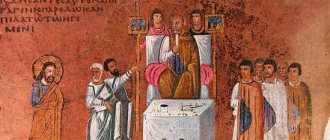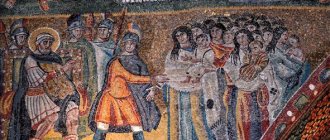Every year after Easter, throughout Bright Week, on the lectern of each church there is an icon of the descent into hell, which speaks of the miracle of the Resurrection of Christ, incomprehensible to the simple human mind. The feat accomplished by the Savior is of key importance both for the Christian faith and for all humanity. After all, He atoned for human sins, including the sins of those who had long since fallen asleep at the time of His preaching.
It is about how Christ went to hell in order to save from the sins found there that the icon speaks. This feat was accomplished before the Resurrection and testifies to the indescribable goodness and mercy of the Lord. After all, the Savior goes to the underworld in order to preach there too, to rescue the Old Testament righteous, as well as the founders of the human race: Adam and Eve.
As you know, it is original sin that determines the original sinful nature of modern people. However, Christ saves Adam and Eve, atones for the sins of these people and also gives everyone the hope of salvation in him.
The Gospel texts do not describe the process of traveling to the underworld as such. A detailed description is contained in the apocryphal Gospel of Nicodemus. By the way, for this reason, for a long time, the iconographic plot of the Resurrection was combined with the plot of the descent.
Preached in hell for three days?
There are places in the Bible where the Holy Spirit tells us that Jesus “preached in hell” while he had been dead for three days.
Is it true that when Jesus died, he went down to hell and brought the Gospel there, preached and made it possible to receive forgiveness?
There may be several points of view. I propose today to look into the question posed in more detail. We will go through each passage, studying it in detail.
1 Pet. 3:17-22 Synodal translation
17 For, if it pleases the will of God, it is better to suffer for good deeds than for evil;
18 For Christ also suffered once for our sins, the righteous for the unjust, to bring us to God, being put to death in the flesh but made alive in the Spirit,
19 to whom He and to the spirits in prison went and preached,
20 They were once disobedient to the long-suffering of God that waited upon them, in the days of Noah, during the building of the ark, in which a few, that is, eight souls, were saved from the water.
21 So now baptism, like this image, saves us, not the washing away of the uncleanness of the flesh, but the promise to God of a good conscience, through the resurrection of Jesus Christ,
22 Who, having ascended into heaven, is at the right hand of God, and to whom the angels and authorities and powers were subject.
1 Pet. 3:17-22 Modern translation
3:17 For it is better to suffer for a righteous act, if it is the will of God, than for an unrighteous one.
3:18 For Christ himself also died for our sins once and for all, the Just for the unrighteous, to bring you to God. His body was put to death, but His Spirit was restored to life,
3:19 in which He went and proclaimed to the spirits in prison,
3:20 to those who disobeyed God in the distant past, during the time of Noah. But God waited patiently until the ark was built. Only a few fell into it, only eight people, and they escaped by water.
3:21 This water is a type of baptism, which saves you even today. Baptism is not the washing of the body from dirt, but a request to God for a clear conscience. All this comes through the resurrection of Jesus Christ,
3:22 Who is at the right hand of God, having been ascended into heaven, and together with the angels, all powers and powers bowed down before Him.
We have here not only one of the most difficult passages in 1 Peter, but one of the most difficult passages in the entire New Testament.
One of the most difficult articles of faith is based on this passage: “ He descended into hell .”
The theme of Christ's victory over death is widely represented in liturgics and iconography
The victory of Christ over death has become one of the favorites of the authors of icons and church hymns. On icons in different scenes, the Savior leads Adam and Eve out of hell, or simply leads a group of righteous people. The theme of the resurrection of Christ is closely connected with this plot.
Initially, the iconography of this episode did not exist independently in the Russian and Byzantine traditions. The image of Christ's resurrection in the tomb arose quite late.
An icon with the theme of death and hell exists not so much for prayers, but so that a person does not forget about the victory of Christ over hell and strives for a righteous life.
Icon of the Descent of Jesus Christ into Hell
And here is an example of the same theme in the Service of the Week of the Cross:
“Pilate planted three crosses on Calvary, two of thieves, and one of the Life-Giver. He saw hell, and said to those who are: O my servants and my strength! Who, having planted a nail in my heart, suddenly pierced me with a wooden spear? And I am torn to pieces by my inner pain, I am wounded in my belly, my feelings confuse my spirit, and I am forced to vomit out Adam, and those that are from Adam, given by the tree; the tree bo this brings you into paradise.”
By leaving a comment, you accept the user agreement
Descended to hell
Jesus, when he was dead, preached in hell for three days?
Christ died once for all sins, the righteous for the unjust. The very fact that the righteous had to suffer for the unrighteous is an incredible thing. At first glance this may seem unfair.
As Edwin Robertson put it:
Only unreasonable forgiveness can correct the unpardonable sin. Christ accepted suffering for us, and the mystery is that He, who did not deserve any suffering, accepted and endured this suffering for us, who deserved it. He sacrificed Himself to restore our lost relationship with God.
Peter declares that Christ did this to bring us to God.
At the same time, Peter uses the verb prosagein , translated as lead. This verb has two very clear sources.
a) It has its source in the Jewish worldview.
This verb was used in the Old Testament in connection with the consecration of Aaron and his sons for sacred rites. God commands Moses:
“Bring Aaron and his sons to the entrance of the tabernacle of meeting” (Ex. 29:4).
The meaning, as the Jews understood it, was this: only priests had the right of direct access to God . A simple man could come to the Temple, he could pass through the courtyard of the pagans, the courtyard of the women, the courtyard of the Israelites, but here he had to stop: he could not enter the courtyard of the priests, into the immediate proximity of God; and of all the priests, only the high priest could enter the Holy of Holies.
And Jesus brings us to God, He opens the way for all people to the immediate proximity of God.
b) This verb also has a source in the Greek worldview.
The corresponding Greek noun prosagoge is used three times in the New Testament . Prosagain means to introduce, prosagoge means the right of access, the result of the very act of introducing.
Through Christ we have access to grace.
2 Through whom we have gained access by faith into this grace in which we stand and rejoice in the hope of the glory of God. (Rom.5:2)
Through Him we have access to God the Father.
18 For through Him we both have access to the Father in one Spirit. (Eph.2:18)
Through faith in Him we have boldness and secure access to God (Eph. 3:12).
12 in whom we have confidence and secure access through faith in him. (Eph.3:12)
In Greek, this had a special meaning: at the royal courts there was a special court prosagogeus , who decided who was allowed into the presence of the king and who was not allowed. It was as if he was in charge of the keys that opened access.
Jesus Christ, through what He has accomplished, gives people access to God.
The gospel was preached to the dead
If we move beyond these two verses to the next part of this passage, we can note, with Peter, two great truths connected with the work of Jesus Christ:
- In 3:19 Peter says that Jesus preached to the spirits in prison,
- and in 4:6 - that the Gospel was preached to the dead.
As we will see below, this most likely means that during the time between his death and Resurrection, Jesus actually preached the Gospel in the kingdom of the dead; in other words, to those who in their earthly life did not have the opportunity to hear him, and this contains a great thought:
- the accomplishment of Christ is not limited in space and time;
- God's grace extends to all people who have ever lived.
Peter sees an absolute victory in the accomplishment of Jesus Christ: after the Resurrection, Jesus Christ ascended into heaven and is at the right hand of God, and the angels, authorities and powers submitted to Him (3:22).
This means that the Kingdom of Christ includes absolutely everything both on earth and in heaven.
He brought a new relationship with God to all people; in His death He even brought good news to the dead; in His Resurrection He conquered death; even the angelic and demonic powers submitted to Him; and He shares with God His power and throne.
The suffering Christ became the victorious Christ; the crucified Christ became the crowned Christ.
Prayers
Troparion to the Resurrection of Christ, tone 5
Christ is risen from the dead, /
trampling death by death, /
and gave life to those in the tombs.
Prayer to Holy Easter
O Most Sacred and Greatest Light of Christ, Who shone forth more than the sun throughout the whole world in Your Resurrection! In this bright and glorious and saving laziness of Holy Pascha, all the angels in heaven rejoice and every creature rejoices and rejoices on earth and every breath glorifies Thee, its Creator. Today the gates of heaven have opened, and I, having died, have been freed into hell by Your descent. Now everything is filled with light, the heavens are the earth and the underworld. May Your light come into our dark souls and hearts and may it enlighten our present night of sin, and may we also shine with the light of truth and purity in the bright days of Your Resurrection, like a new creation about You. And thus, enlightened by You, we will go forth in luminosity at the meeting of You, who comes to You from the tomb, like the Bridegroom. And as Thou didst rejoice on this bright day by Thy appearance of the holy virgins who came from the world to Thy grave in the morning, so now enlighten the deep night of our passions and dawn upon us the morning of passionlessness and purity, so that we may see Thee with our hearts, redder than the sun of our Bridegroom, and may we hear once again Your longed-for voice: Rejoice! And having thus tasted the Divine joys of the Holy Pascha while still here on earth, may we be partakers of Your eternal and great Pascha in heaven in the unevening days of Your Kingdom, where there will be unspeakable joy and those celebrating the unceasing voice and ineffable sweetness of those who behold Your ineffable kindness. For You are the True Light, enlightening and illuminating all things, Christ our God, and glory befits You forever and ever. Amen.
( 1 ratings, average: 5.00 out of 5)
Descent into Hell
We have already said that this is one of the most difficult passages, not only in the Epistle of Peter, but in the entire New Testament, and in order to understand its meaning, we must follow the advice of Peter himself and gird the loins of our minds and study it.
The meaning of this passage is contained in the phrase: “ He descended into hell .
First of all, it should be noted that this phrase is extremely misleading.
The idea emerging from the New Testament is not that Jesus descended into hell, but that He descended into Hades .
As all the latest translations correctly show, Acts. 2.27 should read
- not “You will not leave my soul in hell”,
- and “You will not leave my soul in Hades.”
The difference is that hell is the place of punishment for wicked people, and Hades is the place where all the dead went.
Jews about the afterlife
The Jews had a unique idea of life in the afterlife. They did not think about heaven and hell, but about a world of shadows, in which the spirits of people moved like shadows in an eternal twilight, where there was neither joy nor strength.
This was Hades: after a person’s death, his soul went there.
Prophet Isaiah writes:
“For it is not the grave that glorifies You, nor death that praises You, nor those who go down to the grave who trust in Your truth” (Isa. 38:18)
and the psalmist echoes him:
- “For in death there is no remembrance of You; in the grave who will praise you? (Ps. 6:6);
- “What good is my blood when I go to the grave? will the dust praise you? will He proclaim Your truth? (Ps. 29:10);
- “Will You work a miracle on the dead? Will the dead rise and praise You? Or will Your mercy be proclaimed in the grave, and Your truth in a place of corruption? Will Thy wonders be known in darkness, and Thy righteousness in the land of forgetfulness? (Ps. 87:11-13);
- “The dead will not praise the Lord, nor all those who go down to the grave” (Ps. 113:25);
- “Whatever your hand finds to do, do it with your strength; for in the grave, where you are going, there is no work, no reflection, no knowledge, no wisdom” (Eccl. 9:10).
The Jews' ideas about the afterlife were reduced to this world of shadows and oblivion, where people were isolated from life, light and from God.
Over time, the idea of steps and circles in the kingdom of shadows arose. Some people believed that people’s souls would remain in this state forever; others considered it a kind of prison in which they would be kept until the final judgment of God, when he would pour out His wrath on them.
Is. 24.2; 2 Pet. 2.4; Rev. 20.1-7
Therefore, we should first of all remember that what is meant here is not hell in our understanding of the word; it means that Christ went to the dead in the kingdom of shadows.
Teaching about the descent into Hades
The doctrine of the descent into Hades is based on two expressions taken from this passage.
They say:
- that Jesus came down to preach to the spirits in prison (3:19)
- and that the gospel was preached to the dead (3:6).
Thinking people and theologians have always had different attitudes towards this theory.
First opinion.
Some would like it not to exist at all. This is an attitude of ignoring, and they try to prove their point in two ways.
- Peter says that Jesus came down and preached to the spirits in the prison of the dead, who had once been disobedient in the days of Noah, during the building of the ark. Some argue that this seems to imply that Jesus preached there in the era of Noah himself, that long before his suffering He cried out to the sinners of Noah’s contemporaries. This gave supporters of ignorance the opportunity to completely put an end to the very idea of \u200b\u200bthe descent into Hades. Many scholars have accepted this theory, but we do not believe that Peter's words had such meaning.
- In Moffat's translation we see something completely different: “In the flesh He (Christ) was killed, but He rose again in the spirit. Enoch also walked in the spirit and preached to the imprisoned spirits who were disobedient when the longsuffering of God waited upon them during the building of the ark in the days of Noah.”
Where did Moffat get this translation from?
The name Enoch never appears in any Greek text. But when studying the texts of Greek authors, scientists sometimes resort to the so-called text correction method. They believe that there are distorted places in the text and suggest changing some words or adding new ones.
Randle Harris has suggested that the word Enoch was omitted from this passage in the rewriting of 1 Peter and that it should therefore be restored.
On what basis can the name of Enoch be connected at all with the present passage?
The fact is that Enoch has always been presented as a charming and mysterious person.
“And Enoch walked with God; and he was no more, because God took him” (Gen. 5:24).
In the era between the Old and New Testaments, many legends about Enoch arose and many famous and important books were written under his name.
According to one legend, Enoch, although human, acted as "God's emissary" to the angels who sinned by descending to earth and seducing mortal women (Gen. 6:2).
The book of Enoch says that he was sent to earth from heaven to announce to the angels the final decision about their fate (Enoch 12:1), and announced to people that for their sins there would be neither peace nor forgiveness forever centuries (“Enoch” 12 and 13).
Thus, according to Jewish legend, Enoch actually went to Hades and preached destiny to the fallen angels. And Randle Harris suggested that the passage we are examining in the First Epistle of Peter does not concern Jesus, and Moffat agreed with him and, accordingly, made his translation, indicating the name of Enoch.
This is an extremely interesting and original assumption, but it must undoubtedly be discarded: there is no evidence in its favor. Yes, it would be unnatural to cite the name of Enoch here when talking about the accomplishments of Christ.
Second opinion.
The second approach is to limit it.
Representatives of this theory, and among them there are very important interpreters of the New Testament, believe that Peter actually says that Jesus went down to Hades and preached, but that He in no way preached to all the inhabitants of Hades.
Different interpreters limit the circle of sinners to whom Christ preached in different ways.
1. Some believe that Jesus preached only to the souls (spirits) of people who were rebellious in the time of Noah.
People who hold this point of view often begin to argue further that since those sinners were so rebellious that God sent a flood and destroyed them (Gen. 6:12.13), we can consider that God's mercy is prepared for every person.
These were the worst of sinners, and yet God gave them another opportunity to repent; and therefore even the worst of men still have a chance of salvation in Christ.
2.Others claim that Jesus preached to the fallen angels and preached to them not salvation, but final and terrible damnation.
We have already mentioned these angels: they are spoken of in Gen. 6.1-8.
They were seduced by the beauty of mortal women; they descended to earth, seduced these women and conceived children; and it was precisely because of these actions of theirs that man’s depravity was great and his thoughts were always evil.
In 2 Pet. 2:4 these fallen angels are said to have been sent to hell to await judgment for punishment. It was to them that Enoch preached, and some scholars believe that from this passage it does not at all follow that Jesus preached mercy and another possibility of salvation: crowned with the symbol of His complete victory, He, in their opinion, preached the Last Judgment.
3.Others claim that Christ preached only to those who were righteous and led them from Hades to the paradise of God.
We have already talked about the Jewish belief that all the dead go to Hades, the shadow world of oblivion. So, some scientists argue that this really was the case before Christ, but that He opened the gates of heaven to humanity; at the same time, Jesus descended into Hades and told the good news to all the righteous of past generations and led them to God.
This is truly a majestic picture.
Proponents of this theory usually go even further and claim that thanks to Christ, there is now no need to spend time in the world of shadows, in Hades, and the door to heaven is open to us as soon as the doors of this world close behind us.
Descended into the world of the dead and preached the Gospel there
Others still believe that Peter says that Jesus Christ, during the period between Death and Resurrection, descended into the world of the dead and preached the Gospel there.
Peter says that Jesus Christ was put to death in the flesh, but was raised to life in the spirit, and that He preached this in the spirit.
The meaning of this is that Jesus lived in human flesh and that during the era of life in the flesh, all restrictions of time and space applied to Him; and He died and His body was broken and bled to death on the cross. And when He rose again, He rose again in a spiritual body, in which He was free from the inherent weakness of man and freed from the limitations of time and space.
It was in this spiritual state of perfect freedom that, in their opinion, preaching to the dead took place.
As you can see, this theory operates in outdated categories. She speaks of the descent into Hades, and the descent itself presupposes a three-story structure of the universe, in which the heavens are located above the firmament and Hades below the earth. But, if we put aside the physical categories of this theory, we see in it three enduring and most precious truths.
1. If Christ descended into Hades, then His death was not untrue. This cannot be explained by some kind of fainting on the cross or anything like that: Christ really experienced and knew death and rose again.
The theory of the descent into Hades confirms the complete correspondence of the nature of Christ with our human nature, even in the fact that He suffered death.
2. If Christ descended into Hades, this means that His victory has universal significance. And this truth is firmly established in the New Testament. So Paul says that at the name of Jesus every knee will bow, in heaven, on earth and under the earth.
10 So that at the name of Jesus every knee should bow, in heaven and on earth and under the earth (Phil. 2:10)
In Rev. 5:13 Every creature sings a hymn of praise, in heaven and on earth and under the earth and on the sea.
13 And every creature that is in heaven, and on earth, and under the earth, and on the sea, and everything that is in them, I heard saying: To him that sits on the throne, and to the Lamb, be blessing and honor and glory and dominion forever and ever. (Rev.5:13)
He who ascended into heaven was the first to descend into the depths of the earth.
9 And what does “ascended” mean, if not that He also descended first into the nether regions of the earth? 10 He who descended, He is also the one who ascended above all the heavens, to fill all things. (Eph.4:9,10)
All New Testament thinking is permeated with the idea that the entire universe was submitted to Christ.
3. If Christ descended to Hades and preached there, then there is no corner in the world where the good news of God’s mercy would not reach.
This passage answers one of the most haunting questions raised in connection with the Christian faith - what should happen to those to whom the gospel has never reached?
Without repentance there can be no salvation, but how can repentance come to those who have not received any idea of the love of God and His holiness? If there is no other name by which people can be saved, what will happen to those who have never heard His name?
This is what Justin Martyr once said:
“The Lord, the Holy God of Israel, remembered His dead sleeping in the damp earth, and came down to them to tell them the good news of salvation.”
The doctrine of the descent into Hades contains the precious idea that all people who ever lived were able to see Christ and were offered salvation.
Many people who repeated the Apostles' Creed found the phrase "descended into hell" either meaningless or overwhelming, and silently set it aside and forgot it.
It may well be, however, that it should be perceived more as a poetic image than as a theological teaching.
But it contains these three great truths:
- that Jesus Christ knew death,
- that the victory of Christ is worldwide
- and that there is no corner in the universe where God’s mercy has not reached.
Christian Baptism
Peter was just speaking about the wicked people in Noah's day, disobedient and perverse; they were all destroyed. But in the course of this destruction, eight people - Noah, his wife, his sons Shem, Ham and Japheth, and their wives - were saved from the water in the ark. And immediately the words salvation from water turn Peter’s thought to Christian baptism, which also represents salvation through water.
Peter literally says that Noah and his family are types of baptism. This word demonstrates a special relationship to the Old Testament.
There are two closely related words; typos , which means seal, and antitypos , which means seal impression. It is quite obvious that the closest correspondence exists between the seal and its impression.
Thus, in the Old Testament there are prototypes of people, events and customs that have their analogies in the New Testament.
The persons and events in the Old Testament are like seals, the persons or events in the New Testament are like the impressions of those seals; one corresponds to the other. It can be expressed this way: events in the Old Testament symbolize and foreshadow events in the New Testament.
The science of identifying types and analogues in the Old Testament has achieved great success: let's take a simple and obvious example - the Passover lamb and scapegoat, who took on the guilt of people, are a type of Jesus; the ministry of the high priest and his offering of sacrifices for the sins of the people is a prototype of the accomplishments of Jesus for the salvation of people.
Here Peter sees in the salvation of Noah and his family from the water a prototype of baptism.
In this passage Peter notes three great aspects of baptism. We must remember that at that time only adults who converted directly from paganism to Christianity were baptized in the Church, who accepted their salvation by faith and testified to this before everyone.
1. Baptism is not just a physical cleansing, it is a spiritual cleansing of the heart, soul and life itself. It should have an impact on a person’s soul and on his life.
2. Peter calls baptism a promise to God of a good conscience (v. 21). At the same time, Peter uses the word eperotema , translated as promise.
In ancient times, part of every business agreement was the question: “Do you accept the terms of the agreement and are you bound to abide by them?” The answer “Yes” made the agreement binding on the contracting parties. Without this question and without this answer, the contract was considered invalid.
In legal terminology, this question and answer was called eperotema .
Peter is essentially saying that in baptism God asks the person who comes to Him, “Do you accept the conditions of serving Me? Do you accept the privileges and promises associated with it; do you accept the obligations and demands associated with it?”
And in the act of baptism the person answers: “Yes.”
We use the word sacrament, vow.
The corresponding Latin word sacramentum means military oath, the oath of allegiance that a warrior takes upon joining the army.
In modern conditions, this can be compared with gaining full membership in the Church.
When we enter the Church, God asks us: “Do you accept the terms of service to Me, with all the associated privileges and obligations?” and we answer: “Yes.”
It would be good if everyone clearly understood what they were doing when they joined the Church.
3.The whole idea and the whole meaning of baptism is connected with the Resurrection of Jesus Christ; the mercy of the risen Lord cleanses us; we commit ourselves to the risen and living Lord, and to Him, the risen and living Lord, we turn with a request to give us the strength to keep our promise.










